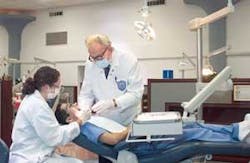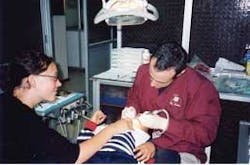Catching A Glimpse of the Snow Leopard
Challenges and Opportunities in Advanced Dental Education at Saint Louis University
Like the daily challenges faced by the elusive and mysterious Himalayan animal, the voyage through dental academia can seem as difficult and the obstacles as formidable.
Broadly speaking, the goals of today’s dental schools are to educate students to serve their patients and communities, prepare students to continue to grow in skill and knowledge over their lifetime in practice, advance the body of knowledge by conducting research, and prepare future educators. This is done within the university context of teaching, research, and service. However, the challenges confronting dental training programs, including at Saint Louis University, are formidable. And, although generally recognized, the challenges are not always adequately understood or appreciated. While reading this summer, I came across an appropriate metaphor for the challenges facing dental schools today.
The snow leopard lives in the high mountain ranges of the Himalayas and is rightly considered the Holy Grail of wildlife photographers. Peter Matthiessen describes his journey to photograph Himalayan blue sheep and catch a glimpse of the elusive and mysterious snow leopard in his book, “Snow Leopard.” Matthiessen’s quest began as an expedition climbing the Tibetan Himalayas, no small feat in itself, but quickly evolved into a pilgrimage of the heart.
This metaphor is appropriate because the journey through the halls of dental academia can seem as difficult and the obstacles as formidable.
Need convincing? Consider these examples. A growing faculty shortage persists because of increasing disparities between faculty salaries and private practice income, increasing student debt that discourages entry into academia, and expectations of higher levels of scholarship required of new dental school faculty-including the expectations of research, high teaching loads, and community service.
These shortages are likely to be exacerbated by the recent reinterpretation of guidelines by the Center for Medicare Services (formerly the Health Care Financing Administration), which effectively ended the majority of support for dental student stipends and dental faculty salaries from the Graduate Medical Education program. Schools will have to make up this shortfall from other sources.
To make matters worse, universities have seen the value of their endowments tumble as markets have declined in an uncertain economy. This has forced university administrators to mandate that many programs “float their own boat.” As a result, dental training programs must be financially self-sufficient and meet budgetary requirements without university subsidies.
Although these are daunting circumstances, the Center for Advanced Dental Education at Saint Louis University is no stranger to overcoming obstacles. In the late 1960s, university trustees were dealing with the same bleak economic conditions that were confronting private universities across the country. Dental education had become enormously expensive, and there were too many dentists (a surplus that proved to be temporary). One by one, private universities were ceding the field to the growing number of state-supported schools of dentistry. The SLU trustees decided in 1967 to close the school, which had a four-year enrollment of 350. When the last Doctor of Dental Sciences degrees were conferred in 1970, a program that had begun in 1894 at Marion Sims College of Medicine - and was taken over by Saint Louis University in 1903 - came to an end.
Led by Dr. Kenneth Marshall, the orthodontic department chair, SLU alumni pledged financial and other support and persuaded university administrators and trustees that the graduate program could pay its own way and should be continued. Consequently, when the dental school shut its doors, graduate work in orthodontics moved forward, funded by expanded clinical services and alumni contributions. This effort was so successful that graduate programs in endodontics and periodontics were added. The combined program was honored as a center of excellence, and was renamed the Dreiling-Marshall Center for Advanced Dental Education in 1998. From a modest beginning in the basement of a red brick row house on Caroline Street in midtown St. Louis, the Center now occupies 47,000 square feet in a modern, well-equipped, state-of-the-art dental education facility.
Today, CADE is widely acknowledged for the quality of its programs, each of which strives to balance progressive excellence with the highest ethical standards. Each CADE graduate leaves the school prepared as an astute and aware clinician using an integrated, multidisciplinary approach to care for cranial, facial, and dental patient problems. Dr. Rolf Behrents, executive director of CADE, puts it this way:
“I want our graduates to be people who become ‘built of good fabric’ while they are here, who are skilled at what they do, and who are compassionate to the people around them. I want them to aspire toward excellence in life, and in service to their patients,” he said.
As a result, CADE clinic patients experience exceptional, innovative, and multidimensional care with intervention of dental specialties as appropriate, using the best available means in diagnosis, treatment planning, and treatment technique and concept. CADE operates teaching clinics in orthodontics, endodontics, and periodontics. These clinics are supported by 42 orthodontic residents, six endodontic residents, nine periodontic residents, five full-time and more than 25 part-time clinical faculty members, and 15 full-time staff members.
CADE also extends its resources to the community to provide dental education and dental patient care to those in need. For more than a decade, orthodontic students at CADE have been helping meet the needs of St. Louis children who may otherwise not have access to dental care. The CADE orthodontic residents operate a dental clinic at Herbert Hoover Boys & Girls Club three days a week. This is the only on-site dental clinic at a boys’ and girls’ club in St. Louis, and one of only a handful in the United States. Three residents see about 16 or 17 patients each day at the clinic. Services range from cleanings to exams, extractions, fillings, and evaluation of adolescents for orthodontic needs. This program has been so successful that Proctor & Gamble used it as a model to establish clinics in other clubs around the country. Working with Mathews-Dickey Boys and Girls Club - and through funding from two grant programs - approximately 50 inner-city students receive orthodontic, endodontic, or periodontic care at CADE, where specialty residents and faculty provide approximately $75,000 in charitable care each year. The center also opens its doors twice a year to the Give Kids a Smile Program, sponsored by the Greater St. Louis Dental Society and the American Dental Association.
CADE also engages the community of dental professionals in educational activities that facilitate the maintenance and upgrading of the skills, knowledge, technology, and competence of the practicing dentist or dental professional. CADE offers courses related to a variety of issues, all leading to optimal dental health-care delivery. The continuing dental education program strives to initiate and encourage lifelong learning in its graduate, postgraduate, faculty, staff, community dentists, and other allied dental health-care professionals.
While the operation of our clinics, our community service, and our continuing education programs are important aspects of our mission, they exist only in support of our most important objective, the training of dental specialists. The backdrop for this training is Saint Louis University, a Catholic Jesuit institution founded in 1818. It is the oldest university west of the Mississippi. The university is classified by the Carnegie Foundation for the Advancement of Teaching as a Doctoral/Research-Extensive Institution, and enrolls more than 11,000 full- and part-time students. The Center, which operates as an academic division of the Graduate School, offers three advanced dental training degrees in endodontics, orthodontics, and periodontics.
The Graduate Orthodontic Training Program is 30 months in length. The three basic areas of training include an extensive and comprehensive clinical experience that involves diagnosis, treatment planning, active treatment, and retention of patients representing a variety of malocclusions and craniofacial deformities; a didactic core and specialty education that encompasses biomedical sciences as well as clinical concepts; and research related to the discipline. Each year, 14 students are accepted from a pool of more than 200 applicants. Students successfully completing the program receive a Master of Science in Dentistry (Research) degree. The program is fully accredited by the ADA’s Commission on Dental Accreditation. Following completion of the program, graduates are educationally qualified for certification by the American Board of Orthodontics.
The 24-month program in endodontics leads to an MSD (Research) degree. The didactic and clinical phases of the program are conducted at both Saint Louis University and, in close affiliation, at Southern Illinois University School of Dental Medicine, in Alton, Ill. The focus of the training program is threefold:
1 a comprehensive clinical experience involving diagnosis and treatment of all categories of nonsurgical and surgical endodontic cases;
2 the didactic core and specialty courses encompassing biomedical and clinical concepts; and
3 research related to the discipline of endodontics. The program is fully accredited by the ADA’s Commission on Dental Accreditation. Following completion of the program, graduates are educationally qualified for certification by the American Board of Endodontics.
The 36-month graduate program in periodontics leads to the MSD (Research) degree. Didactic and clinical education in graduate periodontics occurs at the host institution, Saint Louis University, as well as at the Implant Center and the main clinic at Southern Illinois University’s School of Dental Medicine. The focus of the training program is threefold:
1 an extensive and comprehensive clinical experience involving diagnosis and treatment of patients representing a wide variety of periodontal problems ranging in complexity;
2 the didactic core and specialty education that encompass the biomedical sciences as well as clinical concepts; and
3 research related to the discipline of periodontology. The program is fully accredited by the ADA’s Commission on Dental Accreditation. Following completion of the program, graduates are educationally qualified for certification by the American Board of Periodontology.
With the storied tradition of dental education at Saint Louis University and the quality of its existing programs, it would be easy to become complacent. However, with the significant challenges facing dental education, now is certainly not the time for complacency. CADE administrators, faculty, and staff seek to meet these challenges head-on.
Currently, CADE is in the midst of a major capital campaign that seeks to provide ample resources to achieve our mission through private donations. This campaign is wrapped around a strategic plan designed to take CADE forward in this new millennium.
It is not surprising that the strategic planning process entailed extensive collaboration among alumni, faculty, staff, students, and administrators. At Saint Louis University, this is called “Shared Vision.” The focus is on developing core values of excellence in teaching, research, and community service. The plan includes: creating an environment that respects, stimulates, encourages, and enables scholarship; advancing interactions with the people and professional communities of St. Louis; advancing the technological capabilities so that it matches contemporary practice and education models and then leads; improving the technological capabilities of the center for use in research; and encouraging innovation in educational and fund-raising activities. The strategic plan provides the framework around which the challenges facing CADE will be met as it seeks to fulfill its mission in providing dental education today.
These challenges beg the question: Why would someone give up a lucrative private practice opportunity to embrace an academic career? The answer is simply to catch a glimpse of the “snow leopard”; when a moment of insight occurs while doing research; when a struggling student finally gets it; when a graduate achieves success in the real world and gives something back. This is when you realize that academic dental medicine is not an expedition. It is a pilgrimage of the heart!
Michael Kurtz, MS, MBA, has more than 15 years of experience in health-care management and research. He is currently the business manager at the Center for Advanced Dental Education at Saint Louis University in St. Louis, Mo. Kurtz owns his own dental practice management consulting firm, Provident Practice Group, LLC. Kurtz can be contacted by telephone at (314) 977-8603 or via e-mail at [email protected].
Take plenty of floss! That’s what travel writers Irv Green, DDS, and Andrea Gross learned when they taught English in China recently. Volunteer vacations give you a first-hand look at things tourists never see. Dentists in some countries - like Dr. Gary Seiden (pictured above), a volunteer dentist in Ecuador - work with local dentists. Visit www.dentaleconomics.com for more. (Photo by Global Volunteers)




